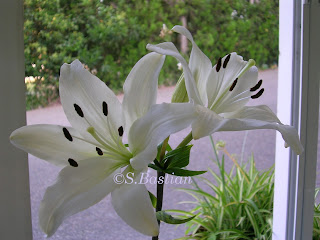Flowers are the reproductive organ of plants.
They carry out sexual reproduction. They have protective parts (calyx and
corolla) and reproductive parts (pistil and stamen).
 |
| Lilium left to open |
The calyx
is made up of sepals. Sepals are usually green. The corolla is made up of
petals. Petals are usually bright colours and have a strong scent. These
characteristics are to attract insects that help carry out pollination. There
is a large variety of shapes, sizes and colours of petals.
The stamen
is the male part of the flower. Different flowers have different number of
stamen. They have 2 parts. The anther and the filament. The anther produces
pollen. The pollen grains contain the male sex cells. The filament is a long
structure that holds the anther.
The female
part of the flower is called pistil. The pistil is in the centre of the flower
and is bottle shaped. The top part is called stigma and it is sticky. This is
where the pollen grains stick after pollination. The long part is called the
style and the bottom part is the ovary. The ovary contains the female sex
cells. The shape of the pistil and stamen vary in different flowers. By
observing flowers you can sometimes tell whether they are pollinated by the
wind or by insects. Flowers that have very long stamen that hang out of the
flower are usually pollinated by the wind. Flowers that have the stamen and
pistil hidden inside the structure of the flower are pollinated by insects also
flowers that have bright colours and strong scents.
We have identified
the parts of flowers. For this experiment we have used lilium. Lilium are very
big flowers, you can see the stamen and pistil very clearly.
We have
observed the flower using a hand lens. We counted the sepals, petals, stamen
and filament, also the anther, filament, stigma, style and ovary.
We touched
the stigma and noticed it was sticky and touched the anther and saw how the
pollen grains stuck to our finger.
After in
our notebooks we wrote all the information collected in the experiment and drew
a scientific diagram of the flower.
 |
| By Rodrigo Contreras - E1C |
We also
looked at compound flowers. If you look at a daisy, at first, you cannot see
any of the parts we have studied. This is because daisies are not only one
flower, in fact, they are made up of hundreds of flowers.
We opened
up daisies and took a close look at each of the components. Each one is a
flower, it has petals, stamen and/or pistil. Each white petal is also a flower.
If you look very carefully you can see the pistil.
Students
were very surprised to see that each of the components of a daisy is a flower.

























